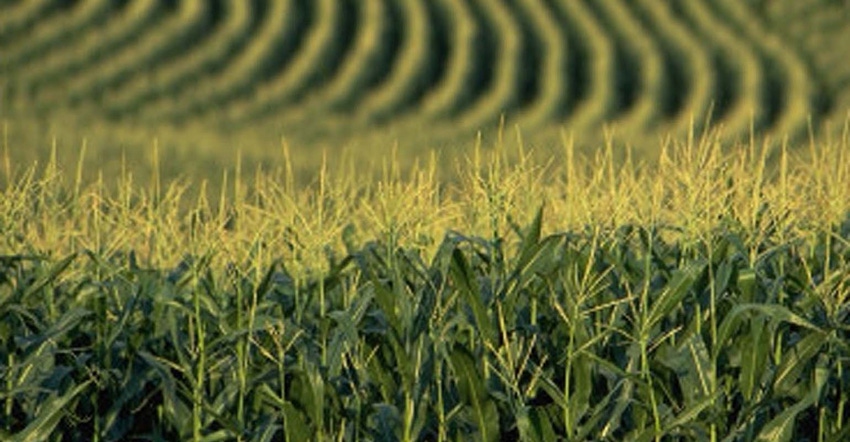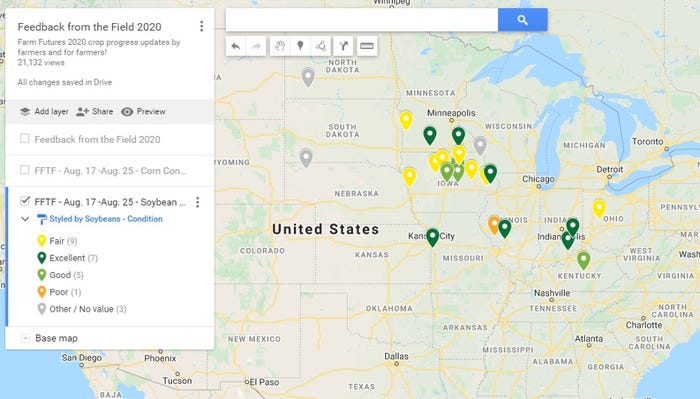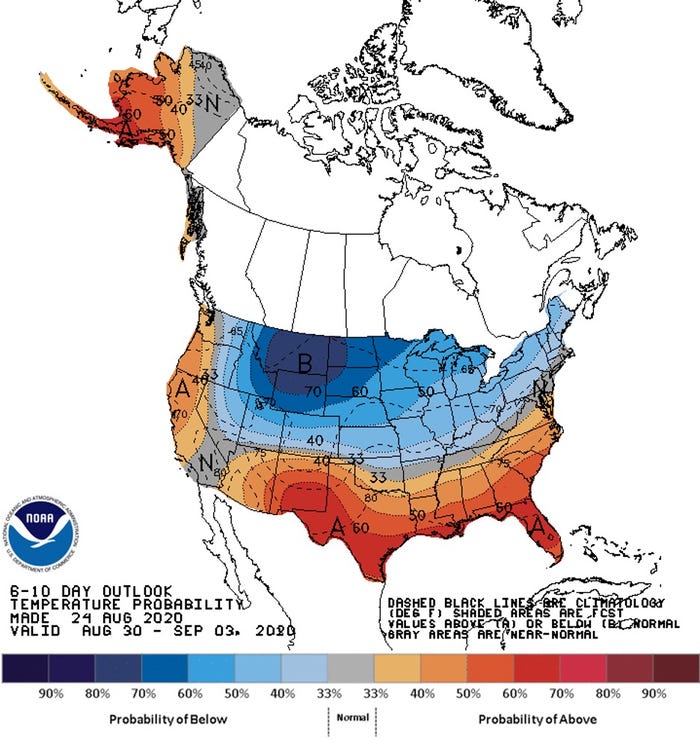
Corn conditions took a major dive in yesterday’s Crop Progress report as more information about the damage to the Iowa corn crop following the August 10 derecho wind storm became available through regional crop tours. For the week ending August 23, corn ratings fell 5% on the week to 64% good to excellent.
Iowa, the nation’s top corn producer and the hardest-hit region in the derecho wind storm’s path, saw a 9% drop in weekly quality ratings to 50% good to excellent. Iowa’s corn ratings have deteriorated by 19% in the weeks following the derecho wind storm as dry conditions in western regions of the state continue to suffer heat stress amid drought conditions.
“75% of our corn is flat from the wind storm,” a Central Iowa Farm Futures reader shared. “Not sure what the quality of the corn will be at harvest if we can even get it off the ground at harvest.”
Hot and dry weather continued to push corn development ahead of historical averages. As of August 23, 88% of the U.S. corn crop had reached the dough stage, with the remaining crop expected to complete the stage within the next couple weeks. Corn denting progress was 44% complete as of Sunday, 5% ahead of the five-year average. And in the first week of USDA’s 2020 measurements of corn maturation, progress remained flat with the five-year average for the same time period at 5%.
“Northern Nebraska panhandle is burning up from lack of rain,” warned a Nebraska grower. “Irrigated corn looks good but dry land corn is done.”
Nutrient uptake issues have been a prevalent concern through the Feedback from the Field series, especially after a late harvest last fall and a quick planting season this spring reduced fertilizer applications. A Southern Indiana farmer echoed these worries last week, stating there is “concern about small ears and nutrient uptake at critical growth periods. Sporadic rain events with a couple weeks of hot and humid periods especially during pollination. Corn is fired nearly to the ear and tissue test shows low NPK available.”
Soybeans fade, but offer more hope than corn
Soybean conditions also took a hit in yesterday’s Crop Progress report, falling 3% to 69% good to excellent for the week ending August 23. Crop conditions in Iowa fell 6% on the week to 56% good to excellent as damage from the August 10 wind storm was more fully assessed over the past week. Iowa is the country’s number two producer of soybeans, following Illinois.
Dry weather continues to threaten yield potential, however. “Recent rains are filling pods, but we don't know how much we got hurt from bloom drop or aborting of pods during our 3-4 weeks of dry weather,” a Kentucky farmer fretted.
Iowa farmers continued battling the heat amid wind damage with one farmer noting, “Beans are dying from drought.” Despite positive crop conditions elsewhere in the Midwest, a central Iowa farmer observed, “top half of soybeans have low pods per node.”

But the soybean crop continues to develop more favorably in the heat than corn. Nearly all soy plants in the U.S. have begun to set pods at 92% complete, 5% ahead of the five-year average. In the first week of USDA’s measurement of leaf dropping progress for the year, 4% of the soy plants had begun dropping leaves, in line with the five-year average.
“Best looking beans with high yield potential I’ve had in three years,” a Missouri Farm Futures reader exclaimed. “Great stand, zero weed pressure, no insect pressure. We are going to need a little rain in the next two weeks to finish them out.”
Wheat harvests continue
With soft red winter wheat harvest complete and hard red winter wheat harvest wrapping up in the Pacific Northwest and Montana, USDA reported that 97% of winter wheat harvests were complete as of August 23. Favorable harvest weather conditions sent harvest progress 4% higher than the previous week and just slightly under the five-year average of 98% for the same time period.
A northwestern Nebraska farmer reflected on the winter wheat harvest in the latest Feedback from the Field survey, noting the crop was, “Average due to dry weather.”
Remaining winter wheat harvest progress will largely depend on how quickly the soft white winter wheat crop will complete harvest in the Pacific Northwest. As of last Friday, the soft white crop was nearly 65% harvested, though the winter crop is much further ahead of the spring crop. Warm and dry weather conditions this week should help harvest paces advance this week. Early yield and quality tests are already coming in at above average levels, which will likely be aided by weather conditions.
Spring wheat harvests for the hard red spring and northern durum wheat crops are behind historic paces, but that should not negatively impact yields or protein quality. Rains in North Dakota and Minnesota last week led to a 49% harvest completion rate for the spring wheat crop. While the figure was 19% higher than the previous week, it slipped 13% behind the five-year average.
But the delay was not necessarily bad news for spring wheat crop conditions. Ratings for the crop improved 1% from the previous week to 71% good to excellent for the week ending August 23, despite rain and hail damage in parts of North Dakota early last week. “Serious hail damage over a large part of this county,” a grower in southwestern North Dakota reported.
Will hurricane rains be too late?
Hurricane season is off to a ferocious start in the Gulf of Mexico as Tropical Depression Marco and Hurricane Laura batter the Texas and Louisiana coasts. But despite the anticipated destruction both storms will inevitably leave in their respective paths, farmers stand to benefit from an increasingly wet forecast.
NOAA’s updated 6 to 10-day outlook forecasts cooler temperatures across the northern two-thirds of the country from August 30 to September 3. The Central Plains and Mississippi River Valley will likely see a 33% - 50% chance of below normal temperatures in that time period, while the Northern U.S. expects even higher chances of cooler temperatures (60% - 70%).

This is good news for Midwestern crops as the forecast will provide a reprieve from heat stress-inducing weather conditions and potentially slow maturation rates. In the Northern U.S., the forecast could slow spring wheat development, extending a harvest season that already lags behind historical averages due to cool and wet conditions this spring.
As Hurricane Laura barrels into the U.S. Gulf, chances for rainfall across the entire reading area – with the exception of the Western U.S. – are slated to increase, with the greatest chances of above-normal rainfall occurring in Missouri, Illinois, and Indiana (60% - 70% chance of above normal precipitation).

While it may be too late for showers to significantly impact corn yields, the higher chances of precipitation could have a positive effect on soybean development. But the window is quickly narrowing – with 92% of soybeans already setting pods, timely rains will help yield prospects if received sooner rather than later.
Follow along with the season:
Feedback from the Field Roundup: Week Ending August 9, 2020 - Dry conditions expected to be exacerbated by yesterday’s derecho winds.
Feedback from the Field Roundup: Week ending August 2, 2020 - Wheat harvest rolls on in the Northern U.S.
Feedback from the Field Roundup – Week ending July 26, 2020 - Improved corn conditions offset drought, wind damage.
Feedback from the Field – Week ending July 19, 2020 - Crops withstand the heat while pastures and rangeland suffer lowest ratings since 2012.
Feedback from the Field: July 7, 2020 - Crops stand up to hot weather – for now.
Feedback from the Field: June 30, 2020 - Despite strong ratings, the corn crop may face challenges during silking process.
Feedback From The Field: June 23, 2020 - Readers report solid corn and soybean crop quality so far this year.
About the Author(s)
You May Also Like






